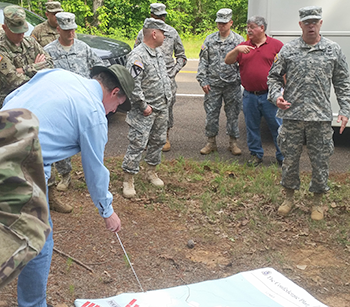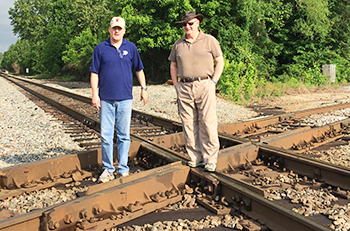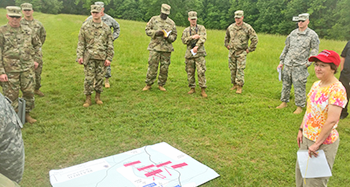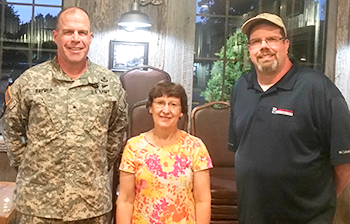
RSU Professor Paul Hatley points to the battlefield map while Brigadier General James Raymer (on far right) explains the relevance of Shiloh to today’s Army. Credit: David Ulbrich.

RSU Professor Paul Hatley (left) and British Army veteran Jim Carrick stand at the railroad crossroad in nearby Corinth, Miss. The Battle of Shiloh was fought to control this key objective. Credit: Jane Johansson.

RSU Professor Jane Johansson listening as Soldiers discuss the actions on the battlefield. Credit: David Ulbrich.

Commandant and Brigadier General James Raymer standing with RSU Professors Jane Johansson and David Ulbrich. Credit: David Ulbrich.
Three Rogers State University history professors joined Soldiers from the U.S. Army Engineer School on a Staff Ride to the Shiloh battlefield in May.
This Civil War battle occurred in April 1862 and saw more than 23,000 casualties during some of the bloodiest combat in the conflict.
RSU Professors Dr. Jane Johansson, Dr. Paul Hatley and Dr. David Ulbrich met in Tennessee with a group of Soldiers led by the Engineer School’s Commandant and Brigadier General James Raymer for the Staff Ride, which took place May 12-13.
Among them were commanders, warrant officers, and senior noncommissioned officers of the Engineer School and the 1st Engineer Brigade, both based at Fort Leonard Wood, Missouri.
A Staff Ride is more than a battlefield tour. Instead, the soldiers researched and played the roles of key combatants at Shiloh like Ulysses S. Grant, William T. Sherman, P.G.T. Beauregard and Albert Sydney Johnson. The U.S. Army has conducted Staff Rides all over the world for more than a century.
“The assistance of the Rogers State personnel was invaluable to the successful planning, preparation, and execution of the Engineer School’s staff ride to the Shiloh battlefield,” said Assistant Commandant and Colonel Jason Smallfield.
“The entire experience was a powerful instrument for the professional development and education of thirty Engineer School leaders.”
The RSU professors worked with the Engineer School’s Command Historian David Chuber and British Army veteran James Carrick. They questioned the Soldiers at each stop on the battlefield about why and how the fighting developed the way it did. They also discussed the effects of weather, terrain, technology, leadership, and morale on the Union and Confederate forces. Lastly, General Raymer offered comments that tied the past and present together.
“Working with these skilled, professional Soldiers as they discussed the battle and applied its lessons to today’s military caused me to think about the entire campaign in new ways,” said Dr. Johansson.
Professors Johansson, Hatley and Ulbrich teach in the Military History program at RSU. This increasingly popular bachelor’s degree is the only one of its kind offered in Oklahoma.
Students have come from as far away as Hawai’i, Alabama, New York to take courses like “The Civil War,” “Introduction to Military History,” and “War and Technology” from these RSU professors.
Questions about the program can be directed to the History and Political Science Department at 918-343-6811.
